#dazaifu tenmangu
Explore tagged Tumblr posts
Text


dazaifu tenmangu, fukuoka prefecture, japan
0 notes
Text
Murderous grudge turned into God of learning, Dazaifu Tenmangu shrine in Fukuoka prefecture!!
Murderous grudge turned into God of learning, Dazaifu Tenmangu shrine in Fukuoka prefecture!! Hi I’m Nobu, I like traveling overseas and in Japan, visited 26 countries! I’m a National Government Licensed Guide Interpreter of English for 10 years. For the people who are interested in and planning trip to Japan ,I show you hidden local information which you have never seen and heard of through…

View On WordPress
1 note
·
View note
Text
日本のトリビアまとめ #0002
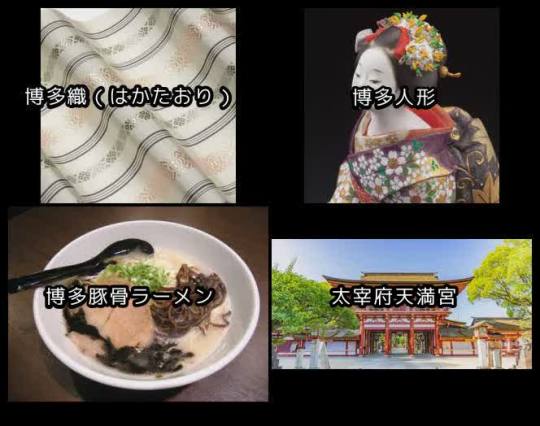
#博多の伝統工芸#Traditional textiles of Hakata#博多の食文化#博多織(はかたおり)#Hakata Tonkotsu ramen#Traditional crafts of Hakata#だざいふてんまんぐう#福岡の織物#Hakata food culture#Hakata-ori#Dazaifu Tenmangu Shrine#Dazaiftenmanguu#Japanese Trivia#Hakata doll#博多人形#太宰府天満宮#博多豚骨ラーメン#日本のトリビア
0 notes
Photo

太宰府天満宮 だざいふてんまんぐう
太宰府天満宮(だざいふてんまんぐう)は、福岡県太宰府市に位置する神社で、菅原道真(すがわらのみちざね)を祀っています。以下に、太宰府天満宮に関する詳細を説明します。 1. 歴史と由来: 太宰府天満宮は、平安時代の学者・政治家であった菅原道真を祀る神社として知られています。道真は、学問や文化の神として尊敬され、彼の死後、天神信仰の中心的存在となりました。彼を祀るため、多くの天満宮が全国各地に建てられましたが、太宰府天満宮はその中でも最も格式の高いもののひとつです。 2. 境内と建造物: 太宰府天満宮の境内には、豊かな自然と歴史的な建造物があります。本殿や拝殿、鳥居などの建築物は、古来の様式を残しつつ、度重なる改修や再建が行われています。境内には、梅の木や枝垂れ桜など季節ごとの花々が美しい景観を作り出しています。 3. 節分祭や学業成就: 太宰府天満宮では、毎年2月25日に菅原道真の命日を祝う「節分祭」が行われます。多くの参拝者が訪れ、豆まきや行列が行われます。また、学業成就や試験合格の祈願をする場所としても知られ、試験シーズンには多くの受験生やその家族が訪��ます。 4. 文化財: 太宰府天満宮の境内には、多くの文化財や歴史的な遺物があります。国の重要文化財に指定された建造物や史跡があり、歴史や文化に興味を持つ人々にとって貴重な場所です。
♪♫♬🎤🎹🎶♪♫♬🎤🎹🎶♪♫♬🎤🎹🎶♪♫♬🎤🎹🎶
Dazaifu Tenmangu Cultural assets of Saga
Dazaifu Tenmangu is a shrine located in Dazaifu City, Fukuoka Prefecture, and is dedicated to Michizane Sugawara. Below are details about Dazaifu Tenmangu Shrine. 1. History and origin: Dazaifu Tenmangu Shrine is known as the shrine that enshrines Michizane Sugawara, a scholar and politician from the Heian period. Michizane was revered as the god of learning and culture, and after his death, he became a central figure in Tenjin worship. Many Tenmangu shrines were built all over the country to enshrine him, but Dazaifu Tenmangu Shrine is one of the most prestigious. 2. Precincts and buildings: The precincts of Dazaifu Tenmangu Shrine are home to rich nature and historical buildings. Buildings such as the main shrine, worship hall, and torii gate have been repeatedly renovated and rebuilt while preserving their ancient style. In the precincts, seasonal flowers such as plum trees and weeping cherry blossoms create a beautiful landscape. 3. Setsubun festival and academic achievement: At Dazaifu Tenmangu Shrine, the Setsubun Festival is held on February 25th every year to celebrate the anniversary of Michizane Sugawara's death. Many worshipers visit, and there is a bean-throwing event and a procession. It is also known as a place to pray for academic success and exam passing, and many examinees and their families visit during exam season. 4. Cultural properties:
0 notes
Text

The latest piece is dedicated to the Nishitetsu Group's TV ad, "Dazaifu."
Nishitetsu Dazaifu Station is embellished with elements from Dazaifu Tenmangu Shrine, which has a thousand-year history ⛩✨
This is the concluding work of the Nishitetsu TV commercial series. It has been an honor to be a part of the project, and I am extremely grateful for the opportunity.
Check out the animation on YouTube!
#art work#illustration#illustrator#digital art#digital painting#digital drawing#digital illustration#animation#anime art#japan art#bus
39 notes
·
View notes
Text
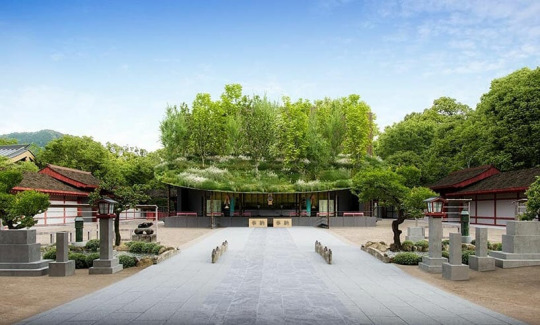

sou fujimoto crowns temporary shrine in japan with planted bent roof
Dazaifu Tenmangu Shrine is the head shrine of Tenmangu shrines in Japan that permanently enshrines the spirit of Sugawara no Michizane, who is widely revered as the god of learning, culture, art, and sincerity. The shrine is worshiped not only all over Japan but also around the world, and nearly 10 million worshipers visit it annually.
159 notes
·
View notes
Text

EGARATE Shrine, giant ginkgo tree. 900-year-old
鎌倉市の荏柄天神社
【Türkçe aşağıda gösterilmiştir】
This section introduces the Egara Tenjinsha shrine in Kamakura and its beautiful sacred tree. It takes about 60 minutes from Tokyo Station to Kamakura Station.
Egara Tenjinsha is dedicated to Sugawara no Michizane, the god of learning. Michizane lived from 845 to 903 and is widely worshipped as a god of learning who helps those who aspire to study and honesty.
The shrine dates back to the first year of Chouji (1104). One fine day, the sky suddenly darkened, and with a thunderstorm, the image of a heavenly god in a black sashes descended from the sky. The villagers, fearing the power of the deity, decided to build a shrine to house and worship the image. The shrine has branches in various parts of Japan, mainly in the Kanto region, and is one of the three oldest Shinto shrines, along with Dazaifu Tenmangu Shrine in Fukuoka and Kitano Tenmangu Shrine in Kyoto.
When visiting the shrine, please ring the bell and bow in the manner of Nirei, Ni-rei, Ni-applause, Ichirei.
Egara Tenjinsha has a sacred tree called Oiginko. According to an old historical document, the villagers planted the ginkgo tree to prevent it from being trampled on because they were in awe of the place where the image of the god Tenjin had descended from the heavens. Therefore, this large ginkgo tree is believed to be around 900 years old, just like the shrine. At 25 metres high and 10 metres in girth, this large tree has an overwhelming presence. The ginkgo tree is very beautiful in autumn, when it turns golden.
Characteristics of ginkgo nuts and how to eat them Ginkgo nuts have a unique flavour and texture and are used in a variety of dishes. Common cooking methods include
Stir-frying: ginkgo nuts can be lightly roasted in a pan and sprinkled with salt to make a tasty and savoury snack. Boiling: Boil ginkgo nuts quickly in boiling water to soften them and make them easier to use in salads and salad dressings. Chawanmushi: Adding ginkgo nuts as an ingredient in chawanmushi adds a subtle sweetness and a unique flavour to the dish.
It is safe to use around 10 ginkgo nuts per day for adults and 5 for children. Allergy note: Some people may have allergic reactions to ginkgo biloba. Try small amounts when eating them for the first time. Proper cooking: ginkgo nuts should be cooked thoroughly before eating. Eating them raw may cause indigestion.
Ginkgo nuts are harvested in autumn and are a popular autumn delicacy. Gingko nuts are often served at Japanese autumn festivals and events in particular, and are enjoyed as a dish that reminds people of the changing seasons.
When visiting Egara Tenjinsha, feel the presence of the large ginkgo trees and ponder the taste and nutritional value of their fruit. Also, on 8 February, a ceremony is held to offer needles. Used needles are inserted into 'soft tofu', to honour their spirits and pray for the improvement of their skills.
Click here for access to Egara Tenjinsha: 74 Nikaido, Kamakura, Kanagawa 248-0002, Japan. Egara Tenjinsha is conveniently accessible by foot or bus from Kamakura Station.
From Kamakura Station on foot: It takes about 30 minutes on foot from the East Exit of Kamakura Station. By bus: take the Keikyu bus from the east exit of Kamakura Station and get off at the Sugimoto-dera bus stop, from where it is a 5-minute walk.
As Kamakura city is dotted with tourist attractions, it is recommended to enjoy a walk around the city.

Egara Tenjinsha is a special place where ancient history and natural beauty merge. Why not pay a visit?
Bu bölümde Kamakura'daki Egara Tenjinsha tapınağı ve onun güzel kutsal ağacı tanıtılmaktadır. Tokyo İstasyonu ile Kamakura İstasyonu arası yaklaşık 60 dakika sürmektedir.
Egara Tenjinsha, öğrenme tanrısı Sugawara no Michizane'ye adanmıştır. Michizane 845-903 yılları arasında yaşamıştır ve çalışma ve dürüstlük isteyenlere yardım eden bir öğrenme tanrısı olarak yaygın bir şekilde tapınılmaktadır.
Tapınağın tarihi Chouji'nin ilk yılına (1104) kadar uzanmaktadır. Güzel bir günde gökyüzü aniden karardı ve gök gürültülü bir fırtına ile birlikte siyah kuşaklı göksel bir tanrı görüntüsü gökyüzünden indi. Tanrının gücünden korkan köylüler, görüntüyü barındırmak ve ona tapınmak için bir tapınak inşa etmeye karar verirler. Başta Kanto bölgesi olmak üzere Japonya'nın çeşitli yerlerinde şubeleri bulunan tapınak, Fukuoka'daki Dazaifu Tenmangu Tapınağı ve Kyoto'daki Kitano Tenmangu Tapınağı ile birlikte en eski üç Şinto tapınağından biridir.
Tapınağı ziyaret ederken lütfen çanı çalın ve Nirei, Ni-rei, Ni-applause, Ichirei şeklinde selam verin.
Egara Tenjinsha'nın Oiginko adında kutsal bir ağacı vardır. Eski bir tarihi belgeye göre, köylüler bu ginkgo ağacını, tanrı Tenjin'in göklerden inen görüntüsünün bulunduğu yere huşu duydukları için çiğnenmesini önlemek amacıyla dikmişlerdir. Bu nedenle, bu büyük ginkgo ağacının da tıpkı tapınak gibi yaklaşık 900 yaşında olduğuna inanılıyor. 25 metre yüksekliğinde ve 10 metre genişliğindeki bu büyük ağaç, ezici bir varlığa sahiptir. Ginkgo ağacı sonbaharda altın rengine büründüğünde çok güzeldir.
Ginkgo fıstığının özellikleri ve nasıl yeneceği Ginkgo fıstığı eşsiz bir lezzet ve dokuya sahiptir ve çeşitli yemeklerde kullanılır. Yaygın pişirme yöntemleri şunları içerir
Karıştırarak kızartma: Ginkgo fıstığı tavada hafifçe kavrulabilir ve üzerine tuz serpilerek lezzetli ve tuzlu bir atıştırmalık haline getirilebilir. Haşlama: Ginkgo fındıklarını yumuşatmak ve salatalarda ve salata soslarında kullanımını kolaylaştırmak için kaynar suda hızlıca haşlayın. Chawanmushi: Chawanmushi'ye bir bileşen olarak ginkgo fıstığı eklemek yemeğe hafif bir tatlılık ve eşsiz bir lezzet katar.
Yetişkinler için günde yaklaşık 10, çocuklar içinse 5 ginkgo fındığı kullanmak güvenlidir. Alerji notu: Bazı insanlar ginkgo biloba'ya karşı alerjik reaksiyon g��sterebilir. İlk kez yerken küçük miktarlarda deneyin. Doğru pişirme: Ginkgo fıstığı yemeden önce iyice pişirilmelidir. Çiğ olarak yemek hazımsızlığa neden olabilir.
Ginkgo fıstığı sonbaharda hasat edilir ve popüler bir sonbahar lezzetidir. Gingko fıstığı özellikle Japon sonbahar festivallerinde ve etkinliklerinde sık sık servis edilir ve insanlara değişen mevsimleri hatırlatan bir yemek olarak beğenilir.
Egara Tenjinsha'yı ziyaret ederken, büyük ginkgo ağaçlarının varlığını hissedin ve meyvelerinin tadı ve besin değeri üzerine düşünün. Ayrıca, 8 Şubat'ta iğneler sunmak için bir tören düzenlenir. Kullanılmış iğneler, ruhlarını onurlandırmak ve becerilerinin gelişmesi için dua etmek amacıyla 'yumuşak tofu'nun içine yerleştirilir.
Egara Tenjinsha'ya erişim için buraya tıklayın: 74 Nikaido, Kamakura, Kanagawa 248-0002, Japonya. Egara Tenjinsha'ya Kamakura İstasyonu'ndan yürüyerek veya otobüsle rahatlıkla ulaşılabilir.
Kamakura İstasyonu'ndan yürüyerek: Kamakura İstasyonu'nun Doğu Çıkışı'ndan yürüyerek yaklaşık 30 dakika sürer. Otobüsle: Kamakura İstasyonu'nun doğu çıkışından Keikyu otobüsüne binin ve 5 dakikalık yürüme mesafesindeki Sugimoto-dera otobüs durağında inin.
Kamakura şehri turistik mekanlarla dolu olduğundan, şehirde bir yürüyüşün tadını çıkarmanız önerilir.
Egara Tenjinsha, antik tarih ve doğal güzelliğin birleştiği özel bir yerdir. Neden ziyaret etmiyorsunuz?
2 notes
·
View notes
Text

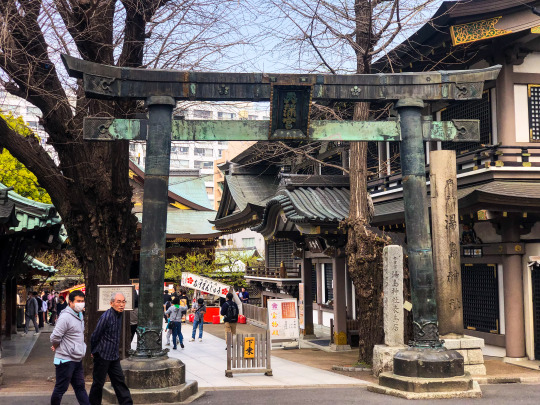
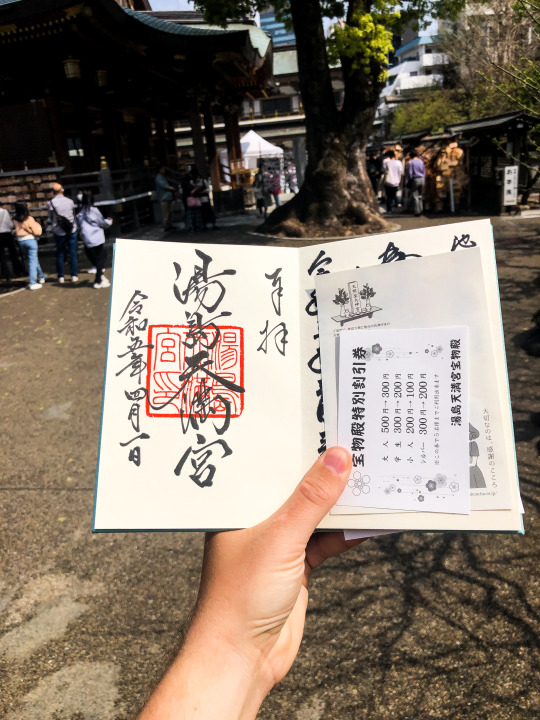
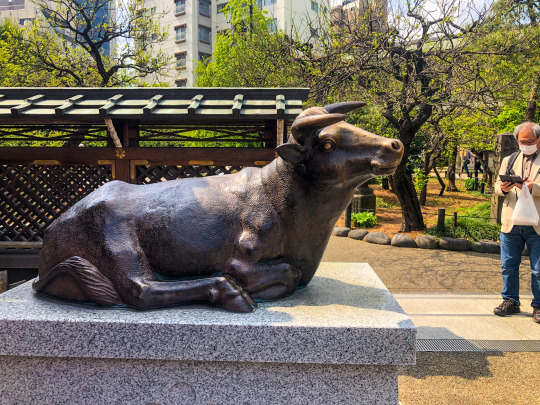

Szóval ma megint kifejezetten szentélylátogató napot tartottam. Az első hely a Yushima Tenmangu szentély volt, ahol több másik szentélyhez hasonlóan ahol már Oszakában és Kiotóban is jártam, Sugawara no Michizane (Tenjin) Kamija lakik. A szentély leginkább a diákok körében népszerű, akik sikeres vizsgákért szoktak itt imádkozni. Itt egész sokan voltak ezen a szép szombat délelőttön, de meglepő módon magamon kívül kizárólag csak japánokat láttam. Egy nagyon szép, rendezett szentély, gyönyörű parkkal és a világ legjóságosabb arcú bikaszobr��val. A Sugawara no Michizane-nek szentelt szentélyekben egyébként azért találhatók meg a bikaszobrok, mert a legenda szerint a költőt halála után egy ökrösszekér húzta a hintót. A bika azonban egy helyen hirtelen megállt, és nem volt hajlandó továbbmenni. Sugawara no Michizane-t később ezen a helyen, Fukoukában temették el, ahol később a Dazaifu Tenmangu szentélyt emelték.
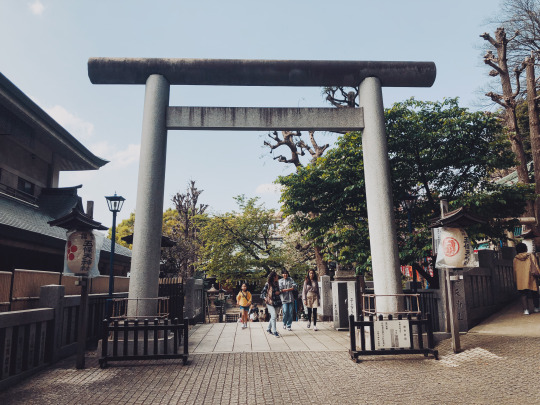

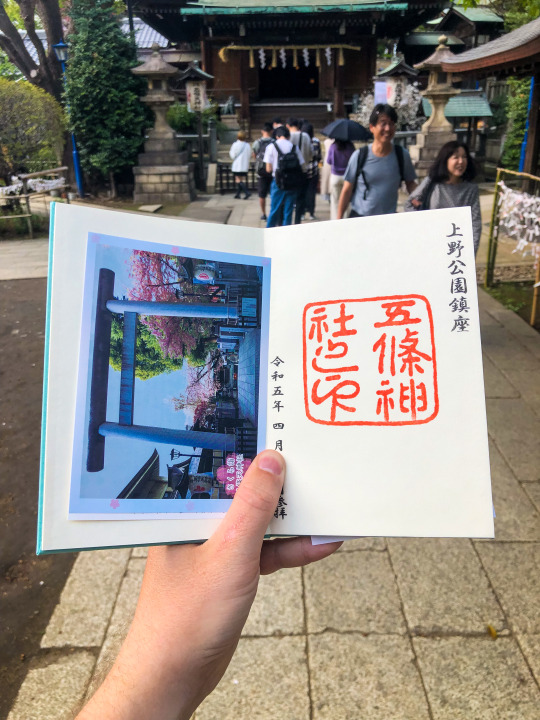
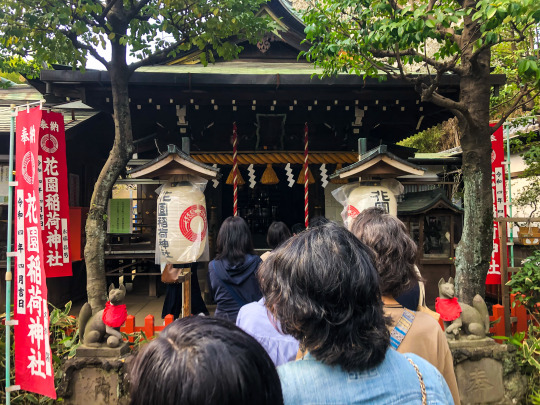
A következő két szentély a Gojoten Jinja és a Hanazono Inari Jinja volt, amelyek gyakorlatilag egy területen találhatók az Ueno Parkban. A Gojoten Jinja három Kamija Okuninushi, Sukunabikona, és Sugawara no Michizane, itt tehát főként betegségekből való felgyógyulásért és sikeres vizsgákért imádkoznak a látogatók. A Hanazono Inari Jinja pedig egy gyönyör kis Inari szentély, sok karmazsinvörös toriival. Mindkét szentély nagyon kellemes és nyugodt hangulatú, a sok turista ellenére is. Így a cseresznyevirágzás idején pedig különösen gyönyörűek.
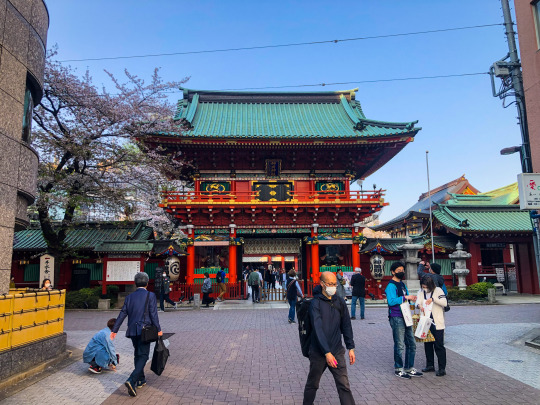
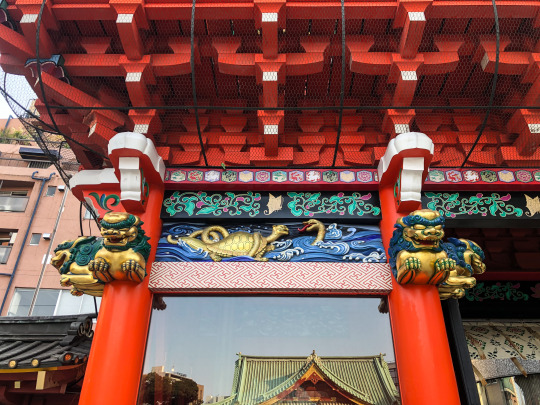
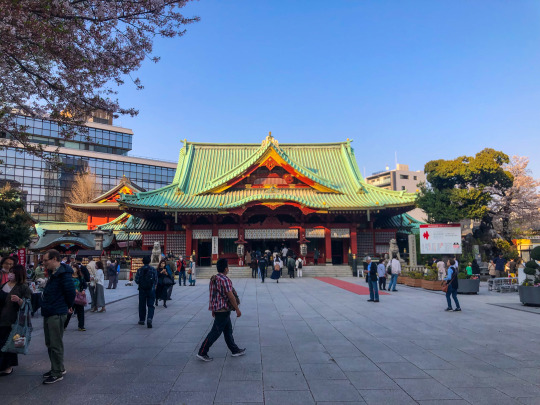



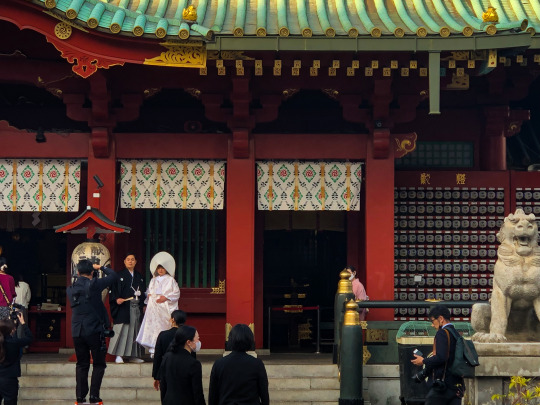
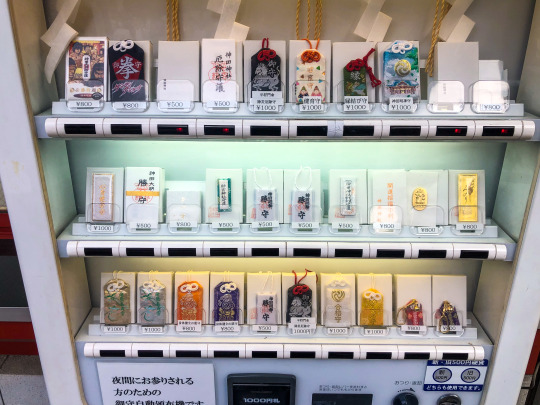
Végül pedig a Kanda-Myojin szentélyban voltam, ami egy minden szempontból lenyűgöző hely. Egyrészt építészetileg, másrészt az 1300 éves múltja miatt, végül pedig azért, mert itt láttam először omamori automatát. Ez a szentély egyébként arról is híres, hogy mivel a tech-világ egyik középpontjában, Akihabarában található, így akár az elektronikai cikkeink védelme érdekébe is vásárolhatunk itt omamorit.
Egyébként édesanyám gyakran mondogatta nekem fiatalkoromban, hogy "hülye vagy, fiam", amit egy ideje nem mondott, mert szerintem azt hiszi, hogy így 30 felett már nem vagyok annyira hülye, de hát az a helyzet, hogy hazafelé betévedtem egy bolhapiacra az Ueno Parkban, ahol a napi (vagy inkább a heti) büdzsém maradékát két dologra verhettem el: az egyik egy Yamato Transport kisautó, a másik pedig az olcsó kimonóárus portékája volt. Szóval hát az a helyzet, hogy kicsit fáj a szívem a kisautó miatt, de belegondoltam, hogy csak 35 éves leszek idén, úgyhogy hirtelen felindulásból vettem egy haorit, ami amúgy szerintem kurva jól néz ki, de így igazából ötletem nincs, hogy mikor és hová tudnám én ezt felvenni, pláne, hogy egy rendes kimono szetthez most akkor minimum egy olcsó nagagit is szereznem kellene obival meg ilyenekkel. DE amúgy annyira kényelmes anyaga van, hogy beszarsz.

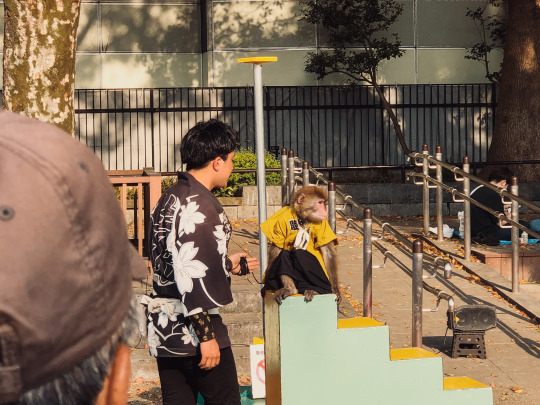
Igen, persze, nyilván tudom, hogy nem így kell hordani, csak úgy felkaptam mutatóba a pólóra és a mackóalsóra, kövezzetek meg. Mazsom-san sokkal elegánsabb nálam.
Ja, amúgy ez a tízezredik posztom.
#Japán#Tokió#goshuin#Yushima Tenmangu Jinja#Gojoten Jinja#Hanazono Inari Jinja#Kanda-Myojin Jinja#gpoy
19 notes
·
View notes
Photo

Found this photo of me while cleaning and sorting things today. This must be at least 17 years old. It was taken on the three bridges that lead into the entrance of Dazaifu Tenmangu Shrine, dedicated to Michezane-sama, the god of scholars and writers. I am delighted an amazed to be able to look back on this photo and know for a fact that I received what I prayed for. (at Dazaifu Tenmangu Shrine, Fukuoka) https://www.instagram.com/p/CoQI3sRPf_N/?igshid=NGJjMDIxMWI=
8 notes
·
View notes
Photo

Tourists entering one of Kyushu's most important Shinto Shrines, the Dazaifu Tenmangu Shrine (太宰府天満宮) — view on Instagram https://ift.tt/xsb173K
2 notes
·
View notes
Text
SHRINES ANCIENT AND MODERN
太宰府天満宮 Dazaifu Tenmangu
Dazaifu Shrine was founded in the 900s. It is one of the most important in Japan, and is thronged with tourists. Toshi and I were among the hordes.




護国神社 GOKOKU JINJA
Near Toshi’s place is a modern shrine from the 1940s, that I had nearly to myself, and I loved the peaceful grounds.



The entrance to shrine is the largest torii gate in all Japan. Made only of unfinished wood, it’s majestic in its simplicity.



1 note
·
View note
Text
Fukuoka Nhật Bản – Du lịch khám phá văn hoá, lịch sử, ẩm thực
Vị trí địa lí và văn hóa lịch sử Fukuoka Nhật Bản
Fukuoka nằm ở phía bắc của đảo Kyushu, Nhật Bản, thuộc vùng Kyushu, có diện tích khoảng 4,987 km2 với dân số khoảng 5 triệu người. Fukuoka có lịch sử hơn 1.000 năm, từng là cảng biển sầm uất và trung tâm giao thương quan trọng, có thành phố Fukuoka là thủ phủ.
Vào thế kỷ 13, thành phố Hakata, tiền thân của Fukuoka hiện đại, trở thành thủ phủ của vùng Kyushu dưới sự cai trị của Mạc phủ Kamakura.
Di tích lịch sử Fukuoka Nhật Bản
Fukuoka là nơi lưu giữ nhiều di tích lịch sử, lễ hội truyền thống, nghệ thuật dân gian và phong tục tập quán mang đậm bản sắc địa phương. Cùng điểm qua các địa điểm du lịch kiêm di tích lịch sử tại đây.
Lâu đài Fukuoka Nhật Bản
Biểu tượng quyền lực của gia tộc Kuroda, từng là trung tâm chính trị và quân sự của vùng Kyushu trong nhiều thế kỷ. Du khách đến Lâu đài Fukuoka có thể tham quan các khu vực khác nhau của lâu đài, bao gồm tháp canh, kho vũ khí và khu nhà ở của lãnh chúa.
Đền Dazaifu Tenmangu
Thờ vị thần học vấn Sugawara no Michizane. Đền Dazaifu Tenmangu là điểm đến lý tưởng cho những ai muốn tìm hiểu về văn hóa và lịch sử Nhật Bản, cầu nguyện may mắn trong học tập và thi cử, đồng thời chiêm ngưỡng vẻ đẹp kiến trúc và cảnh quan thiên nhiên.
Khu phố lịch sử Hakata Nhật Bản
Là nơi lưu giữ những khu chợ truyền thống, nhà hàng lâu đời và những con đường cổ kính, tái hiện bầu không khí hoài cổ của Fukuoka xưa.
Các lễ hội truyền thống tại Fukuoka
Dontaku – Fukuoka Nhật Bản
Lễ hội lớn nhất Fukuoka, diễn ra vào tháng 5 với các hoạt động diễu hành, múa hát sôi động, thu hút đông đảo người dân địa phương và du khách.
Hakata Gion Yamakasa
Là��lễ hội mùa hè Nhật Bản, diễn ra vào tháng 7, lễ hội xe rước thể hiện sức mạnh và tinh thần đoàn kết của người dân Fukuoka.
Yosakoi – Fukuoka Nhật Bản
Là lễ hội múa dân gian đặc trưng của Fukuoka, diễn ra vào tháng 8 với những điệu múa rực rỡ và âm nhạc sôi động.
Nghệ thuật nhân gian tại Fukuoka Nhật Bản
Múa Hakata Odori
Hakata Odori là điệu múa truyền thống của Fukuoka, thường được biểu diễn trong các lễ hội và sự kiện văn hóa. Nếu bạn muốn tham gia múa Hakata Odori, bạn có thể tham gia các lớp học múa được tổ chức tại Fukuoka.
Gốm sứ Arita
Nghề gốm truyền thống lâu đời, nổi tiếng với những sản phẩm tinh xảo và đẹp mắt.
Búp bê Hakata – Fukuoka Nhật Bản
Loại búp bê truyền thống được làm từ đất sét nung, mang nhiều ý nghĩa văn hóa và được sử dụng như quà lưu niệm.
Phong tục tập quán ở Fukuoka
Uống trà đạo
Trà đạo, hay còn gọi là Sado/Chanoyu, là một nghi thức pha trà và thưởng thức trà truyền thống độc đáo của Nhật Bản. Không chỉ đơn thuần là uống trà, trà đạo còn là một nghệ thuật thể hiện sự thanh tao, tinh tế và lòng hiếu khách của người Nhật.
Tắm Onsen
Phong tục tắm suối nước nóng tự nhiên, giúp thư giãn và cải thiện sức khỏe. Tắm Onsen là một hoạt động truyền thống lâu đời của Nhật Bản, mang đến cho du khách cơ hội thư giãn và hòa mình vào thiên nhiên. Onsen là suối nước nóng tự nhiên được khai thác từ lòng đất, có chứa nhiều khoáng chất tốt cho sức khỏe.
Mặc Kimono
Trang phục truyền thống của Nhật Bản thường được mặc trong các dịp lễ Tết, lễ hội và các sự kiện đặc biệt. Kimono là trang phục truyền thống của Nhật Bản, được biết đến với vẻ đẹp thanh lịch và tinh tế.
Ẩm thực phong phú tại Fukuoka
Nơi đây được mệnh danh là “thiên đường ẩm thực Nhật Bản” với vô số món ăn ngon và hấp dẫn, mang đậm hương vị địa phương.
Hakata Ramen
Món mì ramen trứ danh của Fukuoka, với nước dùng tonkotsu đậm đà, sợi mì dai ngon và các loại topping phong phú.
Motsunabe
Lẩu lòng bò hầm cay nồng, là món ăn đặc trưng của Fukuoka được yêu thích bởi hương vị độc đáo và giá trị dinh dưỡng cao.
Mentaiko
Là trứng cá pollock (á minh tái) được tách ra khỏi cá, rửa sạch và ướp muối. Sau đó, trứng cá được ngâm trong hỗn hợp ớt bột, rượu sake và các gia vị khác trong một khoảng thời gian nhất định.
Yaki Udon
Mì udon xào với rau củ và thịt, là món ăn đơn giản nhưng vô cùng thơm ngon và hấp dẫn. Yaki Udon có thể được chế biến với nhiều loại thịt/hải sản khác nhau, chẳng hạn như thịt bò, thịt heo, thịt gà, tôm hoặc mực.
Mizutaki
Lẩu gà hầm thanh đạm, với nước dùng được nấu từ xương gà, rau củ và nấm. hịt gà được sử dụng trong Mizutaki là thịt gà ta hoặc gà chọi được biết đến với độ dai và ngọt thịt.
Tổng kết lại, Fukuoka là điểm đến lý tưởng cho những ai muốn trải nghiệm văn hóa, lịch sử và ẩm thực độc đáo của Nhật Bản. Với sự thân thiện, mến khách của người dân địa phương và những trải nghiệm thú vị, Fukuoka chắc chắn sẽ mang đến cho du khách một kỳ nghỉ khó quên. Tham gia các tour du lịch Nhật Bản Saigontimes Travel để thoả sức khám phá các điều thú vị tại đây.
0 notes
Text
太宰府天満宮宝物殿
太宰府天満宮の宝物殿を訪れた。菅公に負けず劣らず賢そうな牛が出迎えてくれる。

菅原道真の佩刀と伝わる太刀。それが真かどうかよりも、長い間そのように伝わってきたこと自体、あるいはそう伝えられてきたものが残っているということ自体に意味があるのかもしれない。
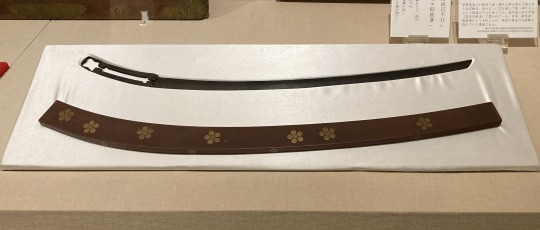
ここから企画展「描かれた天神さま」の展示。菅原道真を描いた絵がたくさん集められている。
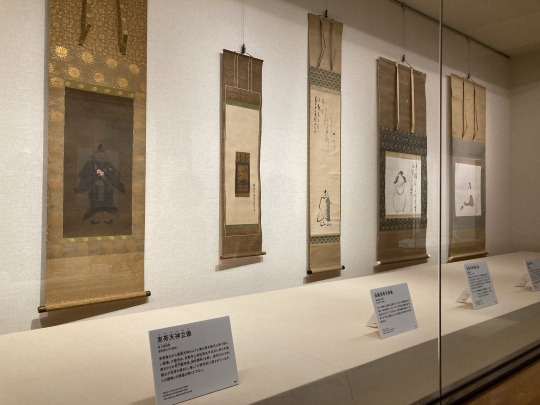
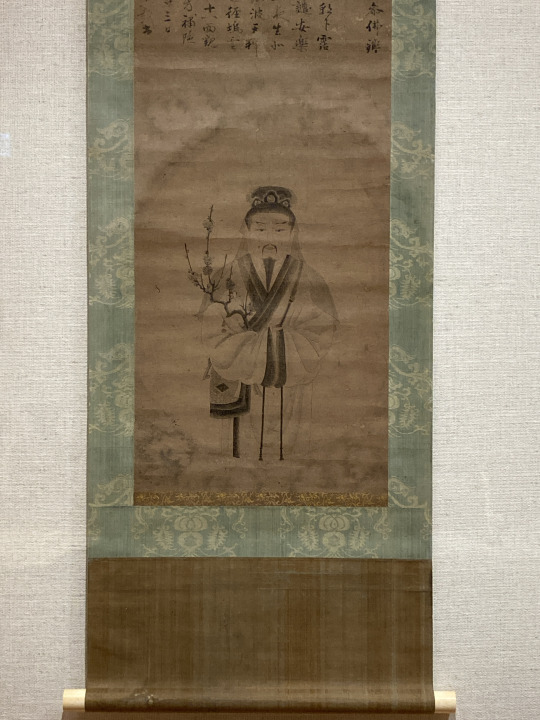

濃淡の墨で描かれた美しさ。

この下の絵は幼少時の菅公を描いたもの。

いちばん一般的に見慣れているタイプの天神像。

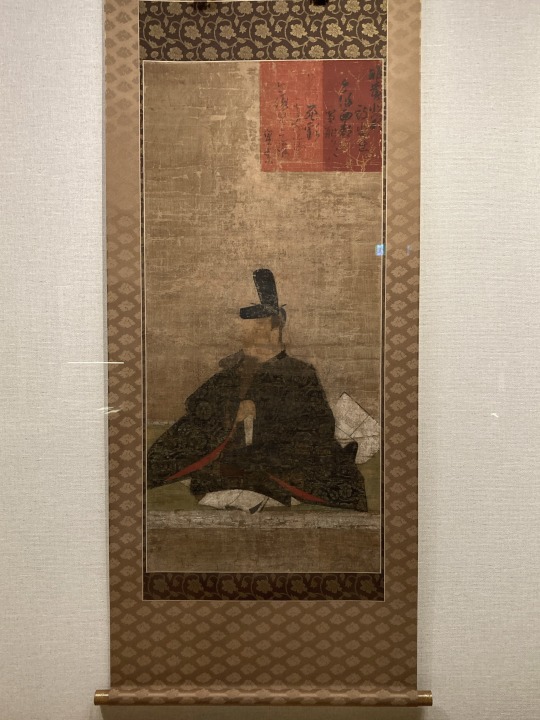
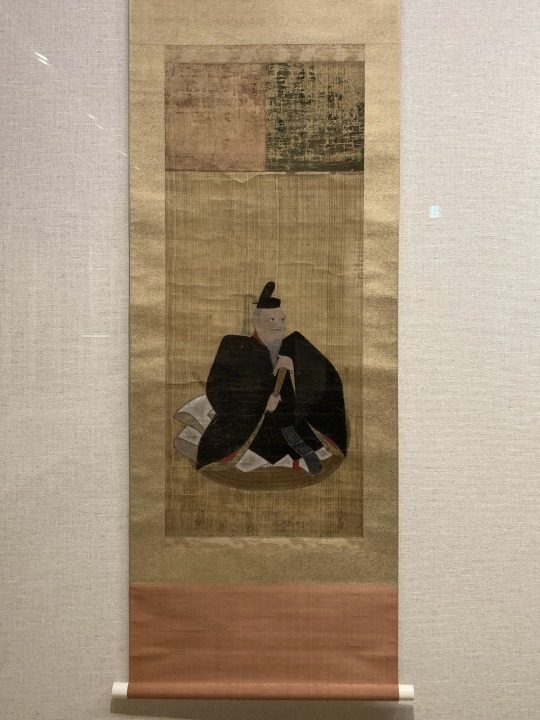


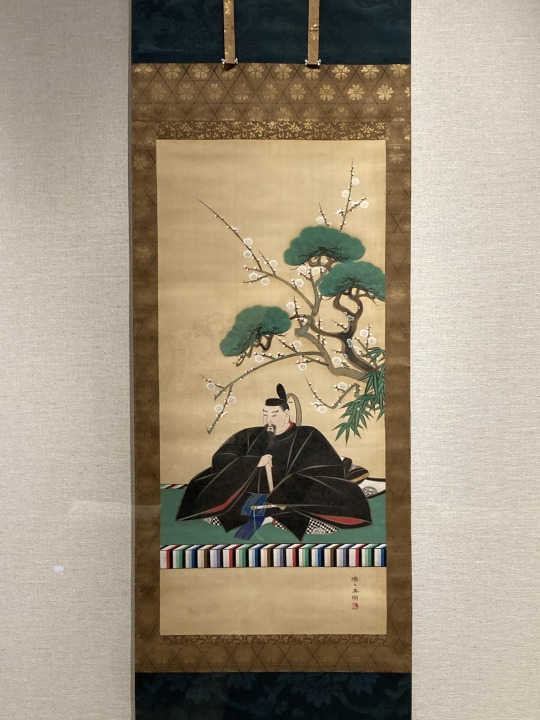
下の3点は唐に渡った設定の天神像。異国風のいでたちである。



これも渡唐天神像。なんだか見たことのあるような作風だなあと思ったら、仙厓だった。

束帯天神像だが、後ろ姿は珍しい由。

背景が印象的な束帯天神像。

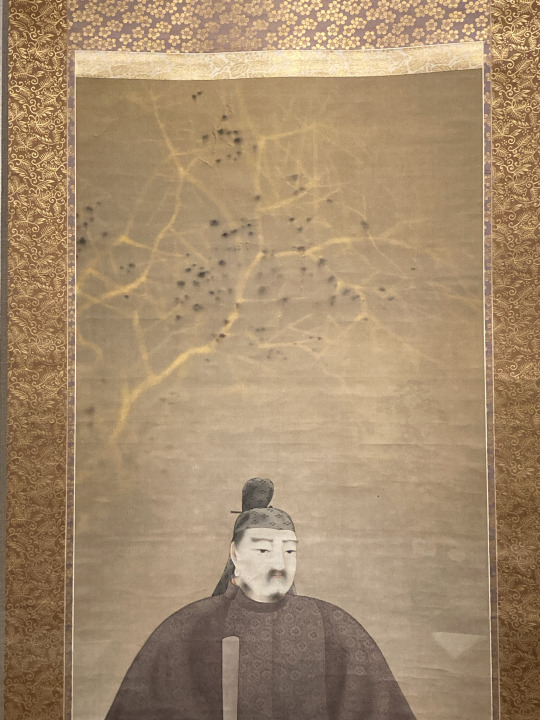
騎牛天神像に見返り菅公立像。


企画展はここまで。
下の写真は屏風の一部で、菅原道真の守り鳥とされる鷽(ウソ)が描かれている(写真中央あたりの小さい鳥)。

ここからは太宰府天満宮のアートコレクションからのセレクション。まさか現代アートがここで見られるとは思っていなかったので、うれしい驚きだった。
サイモン・フジワラ〈Who’s Whobist? (Feeling Blue)〉。自らのマンガのキャラクターをキュビズムのスタイルで再構築している。

ジョージェ・オズボルト〈Best of… vol.1〉。さまざまな絵画作品の再構成。左から順に、ベラスケス、ピカソ、マネ、ゴッホ、デ・キリコ。

菊畑茂久馬〈天河 八〉。全17点のシリーズのうちのひとつ。
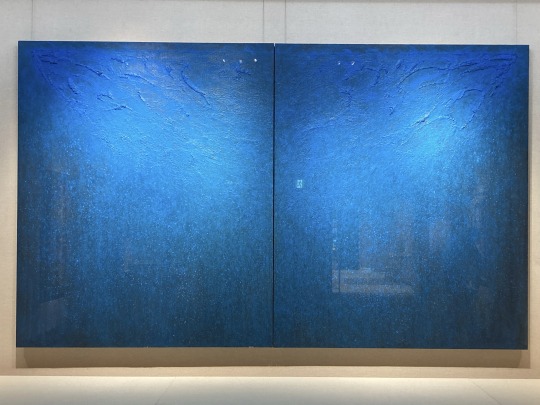
菊畑茂久馬〈静物〉。菊畑は九州派の初期メンバーのひとりとのこと。
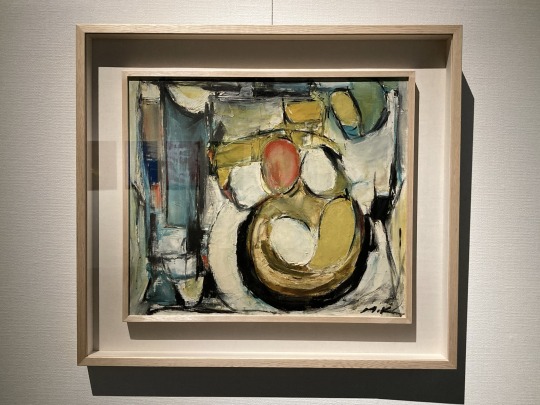
ジェフ・ゲイス〈Black Painting〉。既存の油彩画の一部分を残して黒く塗り潰すスタイル。

田島美加〈Negative Entropy (Dazaifu Tenmangu, Morning Ritual, Purple, Quad)〉。ネガティブ・エントロピーは、音を媒介に日常的な情景を抽象的に可視化するシリーズとのこと。
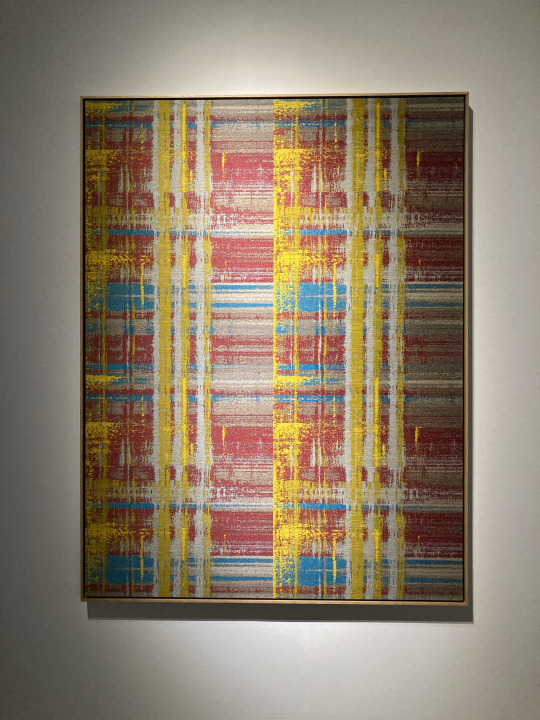
河原温〈Today (1966-2013) MAR. 16, 1967〉。
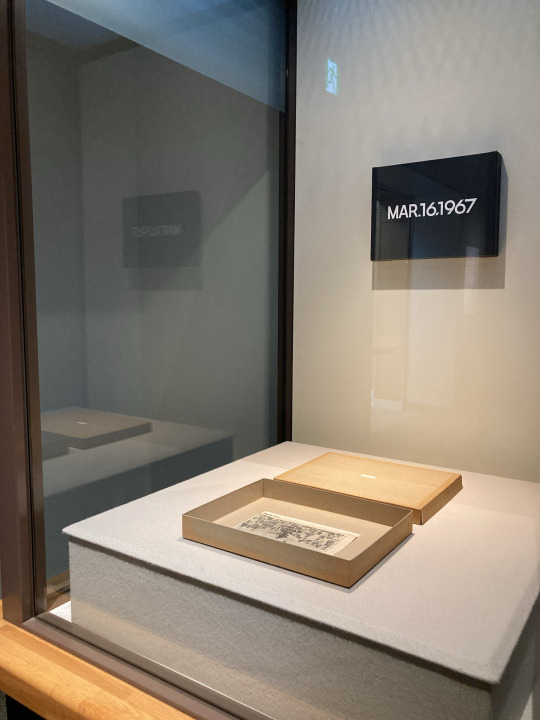
1 note
·
View note
Text
Photo of the Day: Dazaifu Starbucks
Starbucks in Japan seem to be a little different than here in the States. I have come across several specially designed stores in Japan outside of the normal Starbucks fare. This one is along a promenade leading up to Tenmangu Shrine, a very popular shrine. The shrine is dedicated to scholars. The deity was actually a real person, Sugawara Michizane. He had been exiled to Kyushu, where he ended…

View On WordPress
0 notes
Text
Ushijima Shrine Ushijima Shrine where Ushi-oni is enshrined Incarnation of Susano-no-mikoto
Ushijima Shrine, a Shinto shrine founded by the Buddhist monk Jikaku Daishi Ennin
Since it has been in existence for more than 1,000 years, old remains are casually placed here and there. At first, I visited the shrine mistaking it for a Dazaifu Tenmangu shrine because of the word "Ushijima" in the name, However, the atmosphere was completely different.
There is a mysterious legend in "Azuma-kan" (Azuma's Book of History) from the Kamakura period.
In the third year of Kencho (1251), a bull-like apparition appeared in Sensoji Temple, and 24 monks in the dining hall became ill. The 24 monks in the dining hall became ill and seven died. This bull demon ran around the shrine, jumped into Ushijima Shrine, and dropped a ball of beef that he went and made into a sacred treasure of Ushijima Shrine….
What happened to the Ushi-oni is not depicted, but if it were, it might have been sealed and enshrined at Ushijima Shrine.
The shrine is somehow as elegant and boxy as Kyoto . It is not only pure and clean, but also has a mysterious atmosphere of deep darkness.
youtube
1 note
·
View note
Text

Santuario Dazaifu Tenmangu
Famoso por estar construido sobre la tumba de Michizane Sugawara, un erudito, político y poeta que adquirió gran importancia en el siglo IX antes de ser desterrado de Kioto a Dazaifu(prefectura de Fukuoka) debido a su extrema rivalidad con el clan Fujiwara.
Murió en Dazaifu en el año 903 y se piensa que la primera versión de Dazaifu Tenmangu (el patio interior) se construyó en 913.
0 notes